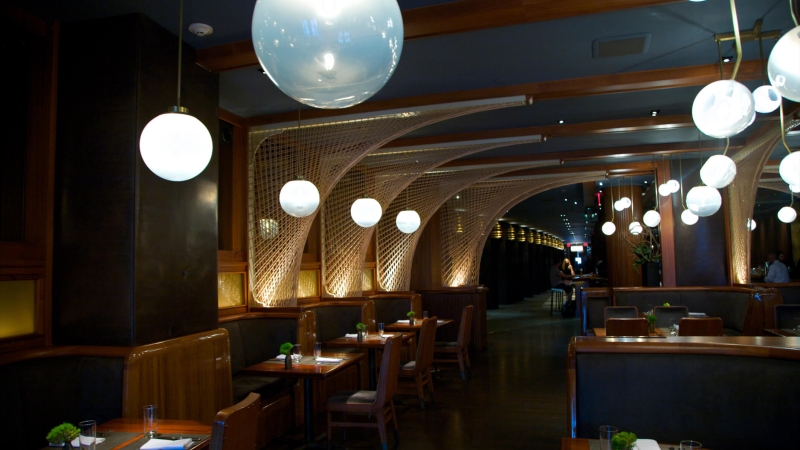Hospitality professionals understand the importance of customer service, cleanliness, and hotel accommodations in securing guest satisfaction, but did you know that hotel lighting can also affect traveller perceptions? In this post, we’re digging into the impact lighting can have on your property’s appeal, atmosphere, perceived value, and more.
Join us as we explore several types of hotel lighting, lighting concepts, and the effects they can have on hotel facilities. From the lobby to guestrooms, you’ll discover how minor lighting changes can significantly impact your hotel’s appearance and how they can help improve guest perception without the cost of major renovations.
The benefits of hotel lighting and how to take advantage of them
Before diving into the distinct types of lighting hotels can use, let’s review the importance of hotel lighting and its effect on the guest experience.
Why is hotel lighting so important?
Hotel lighting plays a large role in creating the property’s atmosphere. It affects how clients view your property and can help create a more memorable guest experience. And although a hotel’s lighting design should fit its environment and the brand’s style, it should also be helpful to both guests and employees. In other words, hotel lighting should be both fashionable and functional.
Lighting is also a wonderful tool to help make your space stand out. High-quality lighting can make hotel spaces appear more vivid, enhancing the colours guests see and helping hotel spaces appear cleaner. Even the most pristine hotel can appear dingy in dim, poor lighting. Research has also shown that lighting conditions can impact people’s behaviours, emotions, and even productivity levels, so hotel lighting plays a key role in the quality of a guest’s stay.
So how do lighting concepts come together to create a cohesive hotel atmosphere? To better understand, let’s look at the various layers of lighting used in creating a lighting design.
The three layers of lighting
Multiple layers of lighting contribute to any business’s general lighting design, and the same goes for hotels. The layers work together to create a dynamic and cohesive look.
- Layer one: ambient lighting
Also called “general lighting,” the ambient lighting layer of your hotel design provides the illumination needed for visitors actually to be able to see the space. The first layouts of ambient lighting are typically figured out when a hotel finalises its architectural plans, as this layer is generally constructed with downlighting, which is installed early in the building process.
The colour temperature of ambient lighting choices also plays a key role in your hotel’s overall lighting design, setting the tone and atmosphere of each hotel space. More lumens are needed to adequately illuminate larger rooms, whereas smaller areas, like guestrooms, require less. Additionally, the lighting temperature you choose should match the purpose and décor of the space.
- Layer two: task lighting
While ambient lighting provides sufficient illumination to see the entirety of hotel spaces, task lighting is more specific; it is used to further light particular areas of a room that guests may use frequently. For example, a suite with a kitchenette may have task lighting that further illuminates cooking surfaces or preparation areas. In public hotel spaces, task lighting may light high-traffic areas, such as the coffee bar, breakfast buffet, or business centre.
Beam angle, colour temperature, and height are key factors to consider when installing task lighting. In areas where safety is a primary concern, such as cooking or preparation areas, tightly angled beam lighting would be more appropriate than candlepower lighting (i.e., LED light fixtures). Candlepower lighting works well for worktables, desks, and concentrated low-risk spaces.
- Layer three: accent lighting
The third layer of lighting in any design concept, accent lighting, complements ambient and task lighting. Accent lighting draws the eye to decorative elements in a room, such as artwork, columns, or other unique architectural designs. This layer provides hotels with the most creativity and space for artistic expression. Adjustable downlights and LED strips are perfect for accent lighting, as they perfectly illuminate distinct hotel features, such as decorative trims, built-in bookcases, or ornate staircases.
Choosing the right levels, hues, and hardware for your lighting concept.
Lighting levels, tones, hues, and strength help create the atmosphere and overall design of every single space in your hotel. For example, warm lighting is more relaxed and calming, which may not be best for working spaces, like meeting rooms or community rooms, but may be ideal for quiet seating areas or intimate hotel restaurants. While warmer tones make us feel more relaxed, research has shown that cooler lighting can impact our energy levels, making us feel more awake—even boosting productivity.
While creating or reinventing the lighting design for your hotel, there are various bulb options to choose from based on the desired result, including:
- High-Intensity Discharge (HID) lamps – bulbs designed to bring a lot of bright light to a large or public space
- Halogen lamps – often used to light area that need good colour and flexible brightness, like workspaces or film sets
- Compact fluorescent lamps – an energy-saving option to traditional incandescent bulbs
- Fluorescent light bulbs – most commonly used in commercial spaces as they use less energy to operate than other forms of lighting
- Light emitting diodes (LEDs) – a newer form of lighting that is versatile enough to be used in many kinds of spaces
Choose the bulbs and lamp options that best suit your hotel’s style, brand, and budget. Work with the sales team to discuss lighting designs for event and meeting spaces, looping in the maintenance department to confirm the logistics of any future hotel lighting replacement plans.
What lighting options are available for hotels?
Different types of lighting are used in various hotel spaces. The lighting design for a guestroom should differ from that of the hotel’s lobby. As we review a range of hotel facilities and the common types of lighting used in each, think about your property and which areas could use a little sprucing up.
- Guestrooms
In most hotel guestrooms, you’ll find removable or plug-in lighting fixtures instead of installed ceiling lights. Many hotels choose not to use ceiling lighting in guestrooms due to height limits and hotel profits.
Installing ceiling lighting in hotel rooms can limit the space cavity hotels have to work with between floors, and contractors must ensure that the floor-ceiling assembly is fire-rated and safe. Building the additional height to accommodate ceiling lighting can also slow the construction of new builds and add to expenses. Instead, the most common types of lighting fixtures used in guestrooms include:
o Floor lamps: Easy to move and install in locations where light is most needed
o Desk lamps: Small, efficient source of task lighting
o Wall lighting: A fantastic source of indirect light and accent lighting
o Bedside lighting: Often dimmable, making it easy for guests to adjust levels to fit personal preferences
Like guestrooms, private guest bathrooms also include specialised forms of hotel lighting. Bright, white light with a high CRI (90-100) allows for the most accurate capturing of colours, making it a popular bulb choice for general hotel bathroom use, particularly makeup or preparation stations. In a guestroom bathroom, you may also encounter specialised accent lighting, such as:
o Vanity lighting: Typically found above or on the sides of mirrors
o LED mirror lighting: Bulbs installed to the outer frame of a mirror
o Can lights: Recessed ceiling lights, sometimes found in guest bathrooms
- The lobby
Build a dynamic hotel lobby lighting design. Don’t be afraid to use different fixtures, levels, and decorative lighting elements to impress hotel guests. While lobby lighting should fit your hotel style and the environment, it is a wonderful way to give travellers a memorable first impression of your property. Feel empowered to use lighting installations we’ve discussed previously, like desk lamps, floor lamps, and wall lighting, but don’t be afraid to add more unique illuminators, like:
o Chandeliers: Both modern and vintage, these eye-catching suspended installations add flair to any sizable lobby or front desk area
o Pendant lights: Versatile, creative, and contemporary hanging light fixtures that work well in dining spaces, hallways, entryways, and the lobby
o Table lamps: Perfect for quiet working areas, like the business centre, private workspace, or a reading nook
o Suspension lights: Hanging lights that come in many shapes, like orbs or even wine glasses, and are great for decoration
- Meeting rooms and event spaces
If your hotel has the space to host large-scale events, spotlights, floodlights, and track lighting could help attract corporate and event planners to your venue. Smaller meeting spaces may benefit from embracing a more minimalist approach that includes flexible, decorative décor designed to meet the needs of a diverse client pool. Placing an embellished chandelier in a small banquet room may not be the best idea, but minimal lighting elements like LED strips and dimmers can help your space to the next level.
- Other hotel facilities
Each area in your hotel should have a unique lighting design that merges cohesively with the rest of the building. When deciding which lighting options you will use in various spaces, consider each facility’s primary function and when it will be open for guest use. For example, a timed lighting system may be beneficial in a fitness centre that is only open during certain hours of the day. Indoor and outdoor pools will also have added lighting requirements, as most pools have lights installed within their structure.
Work with a lighting designer or members of the maintenance team to determine the best options for each of your hotel’s facilities, including:
o Fitness Centres
o Outdoor patios
o Pools
o Guest laundry rooms
o Spas
o Vending stations
o Hotel sundry shops
o Dining areas
o Parking garages or lots
Hotel lighting design tips that can transform your space
Now that you know the different lighting types and illumination styles at your disposal, it’s time to get creative with your hotel lighting design. Whether you are brand new to hotel design or looking for ways to spruce up your property’s appeal, you’ll find helpful tips in the list below.
1. Factor in ceiling height. While light fixtures may be stationary, light can bounce and reflect all around a room. The size of your ceiling can substantially affect how light moves throughout the facility. Hotels with lower ceilings can also use lighting to make the space appear larger, creating the illusion of openness.
2. Take advantage of natural light. Natural light can boost energy and mood, so use natural light wherever possible in your lighting design. Not only is natural light a warm, welcoming mood booster, it can help hotels save money on energy costs.
3. Maintain a cohesive lighting concept. You want to stand out, but not look out of place, so keep your lighting concept consistent in public and private hotel spaces.
4. Create smooth lighting transitions. When guests travel from room to room, the lighting changes shouldn’t catch them off-guard; they shouldn’t be jarring. Transition areas should be brighter during the day, set to match the natural tone of daytime sunlight. Use a dimmer to set transition space lighting to warmer tones during the evening, making it easy for guests’ eyes to adjust seamlessly as they walk inside.
5. Guestroom lighting should be flexible. Install lighting fixtures of assorted styles and brightness levels so guests can work and relax in their rooms.
6. Light for safety. At all hotels, guest safety should be a top priority. Help guests feel safe at your property by ensuring staircases, parking lots, elevators, and other remote areas are amply lit. Install emergency lighting throughout all hotel evacuation routes and on emergency exits.
7. Use efficient lighting. LEDs were a game-changer for many large businesses, including hotels, as they can reduce energy costs and last longer than their consumptive predecessors. Additionally, installing smart lighting is just one of many eco-friendly hotel solutions hotels can use to take their energy efficiency and sustainability efforts to the next level.
Hotel lighting FAQs
1. What is a lighting designer?
A lighting designer manages the execution of a lighting design, including lighting cues, during events like concerts, movie premiers, plays, or on film sets. Lighting designers are hired to manage major private and corporate events, like conventions, symposiums, awards ceremonies, and more.
2. Can hotels change the lighting levels in different spaces?
Some hotels have a main control panel that can control all their event lighting in one place. Certain lighting fixtures instilled with dimmers may be adjusted using these panels, raising lighting levels in one space while lowering them in another. For example, upcoming features in Cvent’s Event Diagramming software will allow hotel event teams to control different lighting panels, change colours, dim lights in one part of the meeting room while lifting them in another, and more.
3. How does recessed ceiling lighting affect hotel maintenance costs?
In-room ceiling lighting can add to hotel maintenance costs, increasing the time required to replace a broken bulb. Replacing the bulb in a floor or desk lamp is much quicker than lugging in a ladder to replace a recessed bulb in the ceiling. Creating an original guestroom design or hotel floor plan focused on plug-in and mobile lighting fixtures will make future renovations much easier.
4. Can new hotel lighting make up for a full renovation?
While installing new hotel lighting is unlikely to compensate for the overhaul that a full-scale property renovation provides, brightening things up can drastically improve your hotel’s interior design. Soft renovations, like replacing outdated light fixtures, can help budget-conscious properties keep their hotels looking fresh and up to date while waiting on the funds required to complete a full property renovation.
Now you know how hotel lighting affects atmosphere, environment, and guest perception!
With a deeper understanding of how important lighting is to an overall design concept, you can identify areas of improvement at your hotel. Look for opportunities to install new lighting fixtures, play with colour temperature, or revamp the entire lighting design for one or more hotel spaces.
As we mentioned, updating hotel lighting doesn’t equate to a full property overhaul, but there are many ways you can update your property through renovative techniques. Up next, we explore additional hotel renovation ideas to revitalise your property, including exterior update ideas, innovative technology solutions, and more.





